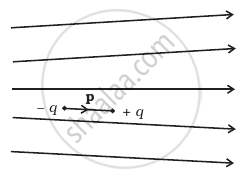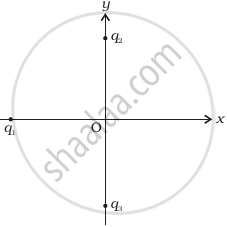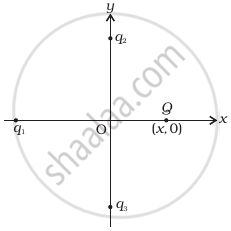Advertisements
Advertisements
प्रश्न
The magnitude of the electric field due to a point charge object at a distance of 4.0 m is 9 N/C. From the same charged object the electric field of magnitude, 16 N/C will be at a distance of ______.
पर्याय
1 m
2 m
3 m
6 m
उत्तर
The magnitude of the electric field due to a point charge object at a distance of 4.0 m is 9 N/C. From the same charged object the electric field of magnitude, 16 N/C will be at a distance of 3 m.
Explanation:
We know that,
E = `(kq)/r^2`
Where E is the magnitude of the electric field, k is constant, q is a charge of magnitude and r is the distance away from the point charge.
Given: E1 = 9 N/C, r1 = 4 and k = `9 xx 10^9` Nm2/C2, E2 = 16 N/C and q is same for both objects.
To find: r2
`E_1 = (kq)/r_1^2`
`9 = ((9 xx 10^9 xx q))/4^2`
`q = ((9 xx 16))/((9 xx 10^9))`
q = 16 × 10-9
`E_2 = (kq)/r_2^2`
`16 = ((9 xx 10^9 xx 16 xx 10^-9))/r_2^2`
`r_2^2 = 9`
`r_2 = 3` m
संबंधित प्रश्न
- An electrostatic field line is a continuous curve. That is, a field line cannot have sudden breaks. Why not?
- Explain why two field lines never cross each other at any point?
Two bar magnets are quickly moved towards a metallic loop connected across a capacitor ‘C’ as shown in the figure. Predict the polarity of the capacitor.

Draw the pattern of electric field lines, when a point charge –Q is kept near an uncharged conducting plate.
Answer the following question.
Draw the pattern of electric field lines when a point charge +q is kept near an uncharged conducting plate.
Answer the following question.
Derive an expression for the electric field due to a dipole of dipole moment `vec"p"` at a point on its perpendicular bisector.
Explain why two field lines never cross each other at any point?
Figure shows electric field lines in which an electric dipole P is placed as shown. Which of the following statements is correct?

Which of the following figures represent the electric field lines due to a single negative charge?
An electron enters an electric field with its velocity in the direction of the electric lines of force. Then ______
In figure, two positive charges q2 and q3 fixed along the y axis, exert a net electric force in the + x direction on a charge q1 fixed along the x-axis. If a positive charge Q is added at (x, 0), the force on q1
 (a) |
 (b) |
